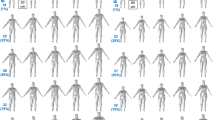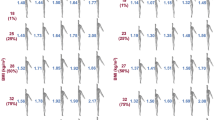Abstract
A novel thermo-physiological human head simulator for headgear testing was developed by coupling a thermal head manikin with a thermo-physiological model. As the heat flux at head-site is directly measured by the head manikin, this method provides a realistic quantification of the heat transfer phenomena occurring in the headgear, such as moisture absorption-desorption cycles, condensation, or moisture migration across clothing layers. Before coupling, the opportunities of the head manikin for representing the human physiology were evaluated separately. The evaluation revealed reduced precision in forehead and face temperature predictions under extreme heterogeneous temperature distributions and no initial limitation for simulating temperature changes observed in the human physiology. The thermo-physiological model predicted higher sweat rates when applied for coupled than for pure virtual simulations. After coupling, the thermo-physiological human head simulator was validated using eight human experiments. It precisely predicted core, mean skin, and forehead temperatures with average rmsd values within the average experimental standard deviation (rmsd of 0.20 ± 0.15, 0.83 ± 0.34, and 1.04 ± 0.54 °C, respectively). However, in case of forehead, precision was lower for the exposures including activity than for the sedentary exposures. The representation of the human sweat evaporation could be affected by a reduced evaporation efficiency and the manikin sweat dynamics. The industry will benefit from this thermo-physiological human head simulator leading to the development of helmet designs with enhanced thermal comfort and, therefore, with higher acceptance by users.




Similar content being viewed by others
References
ASTM F2370-10, 2010 (2010) Standard test method for measuring the evaporative resistance of clothing using a sweating manikin. ASTM International, West Conshohocken
Buono MJ, Ulrich RL (1998) Comparison of mean skin temperature using “covered” versus “uncovered” contact thermistors. Physiol Meas 19:297–300
Burton AC (1944) An analysis of the physiological effects of clothing in hot environments. National Research Council, Canada
Casa DJ, Becker SM, Ganio MS, Brown CM, Yeargin SW, Roti MW, Siegler J, Blowers JA, Glaviano NR, Huggins RA, Armstrong LE, Maresh CM (2007) Validity of devices that assess body temperature during outdoor exercise in the heat. J Athl Train 42:333–342
Curran AR, Peck SD, Hepokoski MA, Burke RA (2014) Physiological model control of a sweating thermal manikin. In: Ambience’14&10i3m, Tampere, Finland, 7-9 Sept 2014, pp. 7–9
Easton C, Fudge BW, Pitsiladis YP (2007) Rectal, telemetry pill and tympanic membrane thermometry during exercise heat stress. J Therm Biol 32:78–86. doi:10.1016/j.jtherbio.2006.10.004
Fan J, Cheng X-J (2005a) Heat and moisture transfer with sorption and phase change through clothing assemblies: part I: experimental investigation. Text Res J 75:900–105. doi:10.1177/004051750507500301
Fan J, Cheng X-J (2005b) Heat and moisture transfer with sorption and phase change through clothing assemblies: part II: theoretical modeling, simulation, and comparison with experimental results. Text Res J 75:187–196. doi:10.1177/004051750507500301
Farrington RB, Rugh JP, Bharathan D, Burke R (2004) Use of a thermal manikin to evaluate human thermoregulatory responses in transient, non-uniform, thermal environments. In: Society of Automotive Engineers Technical Paper. pp. 2004–01–2345. SAE International. doi:10.4271/2004-01-2345
Farrington RB, Rugh JP, Bharathan D, Paul H, Bue G, Trevino L (2005). Using a sweating manikin, controlled by a human physiological model, to evaluate liquid cooling garments, in: Society of Automotive Engineers Technical Paper. doi:10.4271/2005-01-2971
Fiala D, Havenith G (2015) Modelling human heat transfer and temperature regulation, in: Springer-Verlag Berlin Heidelberg (Ed.), Studies in Mechanobiology, Tissue Engineering and Biomaterials. pp. 1–38. doi:10.1007/8415
Fiala D, Lomas KJ, Stohrer M (1999) A computer model of human thermoregulation for a wide range of environmental conditions: the passive system. J Appl Physiol 87:1957–1972
Fiala D, Lomas KJ, Stohrer M (2001) Computer prediction of human thermoregulatory and temperature responses to a wide range of environmental conditions. Int J Biometeorol 45:143–159. doi:10.1007/s004840100099
Fiala D, Havenith G, Bröde P, Kampmann B, Jendritzky G (2012) UTCI-Fiala multi-node model of human heat transfer and temperature regulation. Int J Biometeorol 56:429–441. doi:10.1007/s00484-011-0424-7
Haslam RA, Parsons KC (1994) Using computer-based models for predicting human thermal responses to hot and cold environments. Ergonomics 37:399–416. doi:10.1080/00140139408963659
Havenith G, Richards MG, Wang X, Bröde P, Candas V, Den Hartog E, Holmér I, Kuklane K, Meinander H, Nocker W (2008) Apparent latent heat of evaporation from clothing: attenuation and heat pipe effects. J Appl Physiol 104:142–149. doi:10.1152/japplphysiol.00612.2007
Havenith G, Bröde P, den Hartog E, Kuklane K, Holmer I, Rossi RM, Richards M, Farnworth B, Wang X (2013) Evaporative cooling: effective latent heat of evaporation in relation to evaporation distance from the skin. J Appl Physiol 114:778–785. doi:10.1152/japplphysiol.01271.2012
ISO15831 (2004) Clothing—physiological effects—measurement of thermal insulation by means of a thermal manikin. International Organisation for Standardisation, Geneva (Switzerland)
ISO9920 (2007) Ergonomics of the thermal environment—estimation of thermal insulation and water vapour resistance of a clothing ensemble. International Organisation for Standardisation, Geneva (Switzerland)
Jones BW (2002) Capabilities and limitations of thermal models for use in thermal comfort standards. Energy Build 34:653–659. doi:10.1016/S0378-7788(02)00016-6
Kobayashi Y, Tanabe S (2013) Development of JOS-2 human thermoregulation model with detailed vascular system. Build Environ 66:1–10. doi:10.1016/j.buildenv.2013.04.013
Li Y, Li F, Liu Y, Luo Z (2004) An integrated model for simulating interactive thermal processes in human-clothing system. J Therm Biol 29:567–575. doi:10.1016/j.jtherbio.2004.08.071
Lotens WA (1993) Heat transfer from human wearing clothing. Techincal University Delft, Delft
Lotens WA, Havenith G (1994) Effects of moisture absorption in clothing on the human heat balance. Ergonomics 38:1092–1113
Lotens WA, van de Linde FJG, Havenith G (1995) Effect of condensation in clothing on heat transfer. Ergonomics 38:1114–1131
Mäkinen T, Gavhed D, Holmér I, Rintamäki H (2000) Thermal responses to cold wind of thermoneutral and cooled subjects. Eur J Appl Physiol 81:397–402. doi:10.1007/s004210050060
Martínez N, Psikuta A, Rossi RM, Corberán JM, Annaheim S, (2016) Global and local heat transfer analysis for bicycle helmets using thermal head manikins. Int J Ind Ergon. 53:157–166. doi:10.1016/j.ergon.2015.11.012
Martínez N, Psikuta A, Annaheim S, Corberán JM, Rossi RM (2015) Validation of a physiological model for controlling a thermal head simulator. 16th International Conference on Environmental Ergonomics, Portsmouth
Munir A, Takada S, Matsushita T (2009) Re-evaluation of Stolwijk’s 25-node human thermal model under thermal-transient conditions: prediction of skin temperature in low-activity conditions. Build Environ 44:1777–1787. doi:10.1016/j.buildenv.2008.11.016
Niedermann R, Wyss E, Annaheim S, Psikuta A, Davey S, Rossi RM (2014) Prediction of human core body temperature using non-invasive measurement methods. Int J Biometeorol 58:7–15. doi:10.1007/s00484-013-0687-2
Priego Quesada JI, Martínez Guillamón N, Cibrián Ortiz De Anda RM, Psikuta A, Annaheim S, Rossi RM, Corberán Salvador JM, Pérez Soriano P, Salvador Palmer R (2015) Effect of perspiration on skin temperature measurements by infrared thermography and contact thermometry during aerobic cycling. Infrared Phys Technol 72:68–76. doi:10.1016/j.infrared.2015.07.008
Psikuta A (2009) Development of an “artificial human” for clothing research. De Monfort University, Leicester
Psikuta A, Richards M, Fiala D (2008) Single-sector thermophysiological human simulator. Physiol Meas 29:181–192
Psikuta A, Fiala D, Laschewski G, Jendritzky G, Richards M, Blazejczyk K, Mekjavič I, Rintamäki H, de Dear R, Havenith G (2012) Validation of the Fiala multi-node thermophysiological model for UTCI application. Int J Biometeorol 56:443–460
Psikuta A, Niedermann R, Rossi RM (2013a) Effect of ambient temperature and attachment method on surface temperature measurements. Int J Biometeorol. doi:10.1007/s00484-013-0669-4
Psikuta A, Wang L-C, Rossi RM (2013b) Prediction of the physiological response of humans wearing protective clothing using a thermophysiological human simulator. J Occup Environ Hyg 10:222–232. doi:10.1080/15459624.2013.766562
Psikuta A, Kuklane K, Bogdan A, Havenith G, Annaheim S, Rossi RM (2016) Opportunities and constraints of presently used thermal manikins for thermophysiological simulation of the human body. Int J Biometeorol 60:435–446. doi:10.1007/s00484-015-1041-7
Redortier B, Voelcker T (2010) Implementation of thermo-physiological control on a multi-zone manikin. In: 8th International Meeting for Thermal Manikin and Modeling (8I3M), Victoria, Canada, 22-26 August 2010
Redortier B, Voelcker T (2011) A 38-zone thermal manikin with physiological control: validation for simulating thermal response of the body for sports exercise in cold and hot environment, in: 14th International Conference on Environmental Ergonomics. Napflio, Greece
Rugh JP, Farrington RB, Bharathan D, Vlahinos A, Burke R, Huizenga C, Zhang H (2004) Predicting human thermal comfort in a transient nonuniform thermal environment. Eur J Appl Physiol 92:721–727
Smith CE (1991) A transient three-dimensional model of the thermal system. MSc thesis, Kansas State University, Kansas
Stolwijk JA (1971) A mathematical model of physiological temperature regulation in man. NASA Contractor Report No. CR-1855, National Aeronautics and Space Administration, Washington, DC
Tanabe S, Kobayashi K, Nakano J, Ozeki Y (2002) Evaluation of thermal comfort using combined multi-node thermoregulation (65MN) and radiation models and computational fluid dynamics (CFD). Energy Build 34:637–646
Teunissen LPJ, de Haan A, de Koning JJ, Daanen HAM (2012) Telemetry pill versus rectal and esophageal temperature during extreme rates of exercise-induced core temperature change. Physiol Meas 33:915–924. doi:10.1088/0967-3334/33/6/915
Wagner JA, Horvath SM (1985) Influences of age and gender on human thermoregulatory responses to cold exposures. J Appl Physiol 58:180–186
Werner J, Webb P (1993) A six-cylinder model of human thermoregulation for general use on personal computers. Ann Physiol Anthropol 12:123–134. doi:10.2114/ahs1983.12.123
Wissler EH (1985) Mathematical simulation of human thermal behaviour using whole body models. In: Shitzer A, E.R.C. 1198 (eds) Heat transfer in medicine and biology—analysis and applications, vol 13. Plenum, New York, pp 325–373
Wissler EH, Havenith G (2009) A simple theoretical model of heat and moisture transport in multi-layer garments in cool ambient air. Eur J Appl Physiol 105:797–808. doi:10.1007/s00421-008-0966-5
Wu H, Fan J (2008) Study of heat and moisture transfer within multi-layer clothing assemblies consisting of different types of battings. Int J Therm Sci 47:641–647. doi:10.1016/j.ijthermalsci.2007.04.008
Xu X, Werner J (1997) A dynamic model of the human/clothing/environment-system. Appl Hum Sc 16:61–75
Zhang H (2003) Human thermal sensation and comfort in transient and non-uniform thermal environments. University of California, Berkeley
Acknowledgments
This work has been supported by the State Secretariat for Education, Research and Innovation (SBFI C11.0137) under the grant COST Action TU1101 project (http://www.bicycle-helmets.eu/) The authors gratefully acknowledge Dr. Matthew Morrissey and Rolf Stämpfli from Empa (St. Gallen, Switzerland) for their valuable contribution to programming of the coupling interface and Barbara Koelblen from Empa (St. Gallen, Switzerland) and Warsaw University of Technology (Warsaw, Poland) for providing the validation data and consultation.
Author information
Authors and Affiliations
Corresponding author
Rights and permissions
About this article
Cite this article
Martinez, N., Psikuta, A., Corberán, J.M. et al. Multi-sector thermo-physiological head simulator for headgear research. Int J Biometeorol 61, 273–285 (2017). https://doi.org/10.1007/s00484-016-1209-9
Received:
Revised:
Accepted:
Published:
Issue Date:
DOI: https://doi.org/10.1007/s00484-016-1209-9




